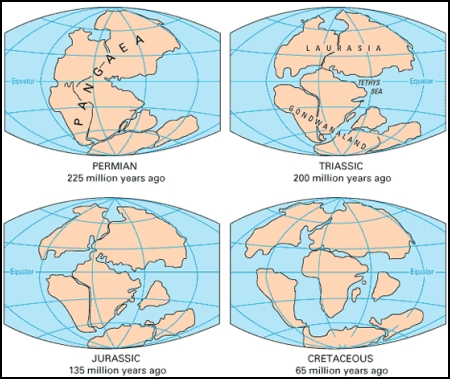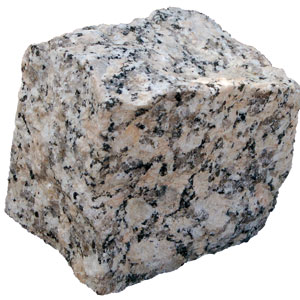
From the guidelines, as from January 2013"People do not need to wait for permission to log your EarthCache. Requiring someone to wait is not supported by the EarthCache guidelines. People should send their logging task answers to you, then log your EarthCache. When you review their logging task answers, if there is a problem, you should contact them to resolve it. If there is no problem, then their log simply stands."

Granite is a common and widely occurring type of intrusive, felsic, igneous rock.  Granite has a medium to coarse texture, occasionally with some individual crystals larger than the groundmass forming a rock known as porphyry. Granites can vary in colour from pink to dark gray or even black, depending on their chemistry and mineralogy. Outcrops of granite often tend to form tors and rounded massifs.
Granite has a medium to coarse texture, occasionally with some individual crystals larger than the groundmass forming a rock known as porphyry. Granites can vary in colour from pink to dark gray or even black, depending on their chemistry and mineralogy. Outcrops of granite often tend to form tors and rounded massifs.
Granites (s.l.) are ubiquitous in Portugal particularly in the north and centre. There are small, scattered granitoids in several locations but the largest majority of granites occur in the north of Portugal. The granites are often zoned and exhibit several facies types within the same granite.
Most of the granites are associated with the Hercynian (also known as Variscan) Orogeny that took place from about 380 – 250 M.a. and is the result of the collision between Laurasia and Gondwana that subsequently led to the formation of the supercontinent Pangea. Because of the widespread distribution of granites in Portugal it is inevitable that they get used for a variety of purposes. These uses vary from the conventional paving to modern art sculptures amongst many other things.
Origin
Granite is an igneous rock and is formed from solidifying magma. Granitic magma has many potential origins but it must intrude other rocks. Most granite intrusions are emplaced at depth within the crust, usually greater than 1.5 km and up to 50 km depth within thick continental crust.
Despite being fairly common throughout the world, the areas with the most commercial granite quarries are located in Finland, Norway and Sweden (Bohuslän), northern Portugal (Chaves and Vila Pouca de Aguiar), Spain (mostly in Galicia and Extremadura), Brazil, India and several countries in southern Africa, namely Angola, Namibia, Zimbabwe and South Africa.
Chemistry
In terms of its major elements granite is composed of the following proportions:
SiO2 — 72.04%; Al2O3 — 14.42%; K2O — 4.12%; Na2O — 3.69%; CaO — 1.82%; FeO — 1.68%; Fe2O3 — 1.22%; MgO — 0.71%; TiO2 — 0.30%; P2O5 — 0.12%; MnO — 0.05%.
Mineralogy
Granite is classified according to the QAPF (Quartz-Alkali Feldspar-Palgioclase-Feldspathoid)  diagram for coarse grained plutonic rocks (granitoids) and is named according to the percentage of quartz, alkali feldspar (orthoclase, sanidine, or microcline) and plagioclase feldspar on the A-Q-P half of the diagram. Granite-like rocks which are silica-undersaturated may have a feldspathoid such as nepheline, and are classified on the A-F-P half of the diagram.
diagram for coarse grained plutonic rocks (granitoids) and is named according to the percentage of quartz, alkali feldspar (orthoclase, sanidine, or microcline) and plagioclase feldspar on the A-Q-P half of the diagram. Granite-like rocks which are silica-undersaturated may have a feldspathoid such as nepheline, and are classified on the A-F-P half of the diagram.
True granite according to modern petrologic convention contains both plagioclase and alkali feldspars. When a granitoid is devoid or nearly devoid of plagioclase the rock is referred to as alkali granite. When a granitoid contains <10% orthoclase it is called tonalite; pyroxene and amphibole are common in tonalite. A granite containing both muscovite and biotite micas is called a two-mica granite. Two-mica granites are typically high in potassium and low in plagioclase, and are usually S-type granites or A-type granites. The volcanic equivalent of plutonic granite is rhyolite.
 How it is obtained
How it is obtained
Granite is obtained in quarries. Quarrying granite is difficult and dangerous, even today. Though some of the technology has changed, quarry workers continue to apply their skill and strength to cutting 9 x 9 x 3.6- m blocks from the rock face one at a time. These blocks in turn are split into smaller 20-ton slabs before being hoisted out of the pit. The blocks are hauled to a large sawing room where they are cut by a diamond-tipped saw, 12 feet in diameter. Usually controlled by computer precision, the blade sweeps across the block cutting it 9 cm deep at each pass. These slabs then move to the cutting shed, where they are split into tile-size pieces by a hydraulic splitter. Curved tiling and round domes are still cut by hand.
Uses of granite
In antiquity - The Red Pyramid of Egypt (c.26th century BC), named for the light crimson hue of its exposed granite surfaces, is the third largest of Egyptian pyramids. Menkaure's Pyramid, likely dating to the same era, was constructed of limestone and granite blocks. The Great Pyramid of Giza (c.2580 BC) contains a huge granite sarcophagus fashioned of "Red Aswan Granite." The mostly ruined Black Pyramid dating from the reign of Amenemhat III once had a polished granite pyramidion or capstone, now on display in the main hall of the Egyptian Museum in Cairo. Other uses in Ancient Egypt include columns, door lintels, sills, jambs, and wall and floor veneer. Many large Hindu temples in southern India, particularly those built by the 11th century king Rajaraja Chola I, were made of granite.
In modern times - Granite has been extensively used as a dimension stone and as flooring tiles in public and commercial buildings and monuments. It is widely used as countertops for kitchens and other hard wearing surfaces because it cleans so easily. A typical northern Portugal pavement will be covered in small cubes of granite.
For recreational purposes - Granite rock climbing is so popular that many of the artificial rock climbing walls found in gyms and theme parks are made to look and feel like granite. Most, however, are made from artificial materials, given the fact that granite is generally too heavy for portable rock climbing walls.
The cache
The cache takes you to an urban location that funnily enough was once surrounded by quarries but instead of quarrying granite, these were quarrying limestone. It seems therefore odd that someone has transported two large granite slabs hundreds of kilometres south and placed them here. Nevertheless, this is a perfect example of the widespread use of granite nowadays and demonstrates the efficacy that geological materials now interact seamlessly with society and most are oblivious to it.
On these granite slabs are cut two particular geometric shapes - what are they? And a particular word is engraved on the bottom right hand side - what is it? The granite is a particular colour. Choose from light-grey, light-pink or yellow and finally get up close to the granite and tell me what is the average grain size of the rock? . E-mail the answers through my profile to validate your find.
Text is adapted from this source
NO tell-tale photos in the logs.
Have fun!

O granito é uma rocha ígnea de grão grosseiro, composta essencialmente por quartzo e feldspatos alcalinos, tendo como minerais acessórios frequentes biotite, moscovite ou anfíbolas. O granito é utilizado como rocha ornamental e na construção civil.Para o sector de pedras ornamentais e de revestimento, o termo granito designa um amplo conjunto de  rochas silicatadas, abrangendo monzonitos, granodioritos, charnockitos, sienitos, dioritos, doleritos, basaltos e os próprios granitos.A composição mineralógica dos granitos é definida por associações muito variadas de quartzo, feldspato, micas (biotite e/ou moscovite), anfíbolas (sobretudo hornblenda), piroxenas (augite e hiperstena) e olivina. Alguns desses constituintes podem estar ausentes em determinadas associações mineralógicas, anotando-se diversos outros minerais acessórios em proporções bem mais reduzidas. Quartzo, feldspatos, micas e anfíbolas são os minerais dominantes nas rochas graníticas e afins.
rochas silicatadas, abrangendo monzonitos, granodioritos, charnockitos, sienitos, dioritos, doleritos, basaltos e os próprios granitos.A composição mineralógica dos granitos é definida por associações muito variadas de quartzo, feldspato, micas (biotite e/ou moscovite), anfíbolas (sobretudo hornblenda), piroxenas (augite e hiperstena) e olivina. Alguns desses constituintes podem estar ausentes em determinadas associações mineralógicas, anotando-se diversos outros minerais acessórios em proporções bem mais reduzidas. Quartzo, feldspatos, micas e anfíbolas são os minerais dominantes nas rochas graníticas e afins.
Portugal tem uma enorme quantidade de granitos especialmente no norte e centro. Muitos destes granitos são zonados exibindo diversas fácies dentro do mesmo corpo.
A maioria dos granitos estão associados aos períodos imediatamente antes, durante ou imediatamete após a orogenia Hercínica que ocorreu entre os 380 e os 250 milhões de anos. Esta orogenia (ou episódio de construção de montanhas) resultou da colisão entre a Laurasia e Gondwana formando de seguida o supercontinente Pangea.
Como a distribuição de granito é tão vasta em Portugal é inevitável que esta rocha seja utilizada para tão diversos fins que variam da típica calçada ao revestimento de pavimentos e prédios e às  modernas obras de arte urbana.
modernas obras de arte urbana.
A cache leva-vos a um típico cenário urbano onde outrora houve nas redondezas algumas pedreiras só que em vez de produzir granito produziam calcário. É portanto um pouco estranho que o projecto de embelezamento da área tenha contemplado o uso de um tipo de rocha estranha à região e que tenha assim resultado no transporte de duas enormes lajes de granito para este local. As nossa novas rotundas, com oliveiras do Alqueva ou os pedaços de arte moderna são um exemplo de como se usam eficazmente materiais geológicos que muitas das vezes passam despercebidos aos transuentes diários.
Para poderem logar esta EC prestem atenção aos seguintes pormenores:
- No topo das lajes estão cortados duas figuras geométricas – o que são?
- Na parte inferior de uma das lajes encontra-se um palavra – qual é?
- Qual a cor do granito usado na construção? (usar entre cinzento claro, rosa claro ou amarelo) e....
- Qual a granulometria média destes granitos?
Enviem-me as respostas a estas perguntas via o meu profile do GC.com para validar o vosso "found".
Nada de fotos reveladoras nos logs! Divirtam-se!


The most exciting way to learn about the Earth and its processes is to get into the outdoors and experience it first-hand. Visiting an Earthcache is a great outdoor activity the whole family can enjoy. An Earthcache is a special place that people can visit to learn about a unique geoscience feature or aspect of our Earth. Earthcaches include a set of educational notes and the details about where to find the location (latitude and longitude). Visitors to Earthcaches can see how our planet has been shaped by geological processes, how we manage the resources and how scientists gather evidence to learn about the Earth. To find out more clickHERE.
______________________________________________________________________________
